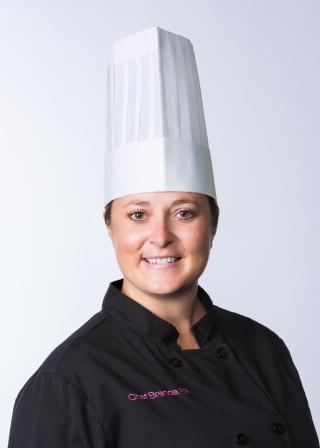Editor’s Note: The new, monthly Chef Profile: Career Path Insights will focus on professional chefs from various facets of the foodservice industry. Culinarians answer questions delving into their views of current foodservice developments and how culinary students can obtain positions within their industries. A goal of this series is to introduce students and instructors to a plethora of foodservice career options. Click here to view the previous profiles.
In what foodservice area do you work?
I am a consultant for Child Nutrition programs as well as for school districts, commodity boards like Pacific Northwest Canned Pear Service, and food manufacturers marketing to K-12 schools.
Describe current foodservice trends you are seeing today.
I see school nutrition professionals getting creative when it comes to dealing with food shortages and that creativity is making lasting impacts. Schools have worked hard to feed their communities during COVID-19, which started with curbside service. Some schools are continuing their curbside service and also stepping up their grab-n-go programs. Additionally, they are growing their breakfast in the classroom services while adding to lunch in the classroom.
Buying local has always been trendy, but with food shortages buying local has gained even more popularity. Local foods, especially fresh produce, are readily available and easy to access. Locally grown produce can sometimes fall into a special category provided by a U.S. Dept of Agriculture program that provides additional money for school districts to buy from local producers. This incentivizes schools to look for U.S. grown produce and support farmers across the county.
Increased scratch and speed cooking techniques, or using ready-made or convenience products and adding fresh ingredients to round out the meal, are also gaining in popularity during these challenging times. With employee shortages, this can be a tricky one. I’ve seen schools offer fewer food items so they have more time for preparation and cooking. For instance, some high schools previously offered three or four entrée choices and now they are offering two. One of those items may be something simple like a grab-n-go sandwich or salad meals so there is time for more scratch preparation and cooking. Schools are also looking at getting creative with staple ingredients in the pantry, like U.S. grown canned pears, and how to use them in new ways that add flavor and texture to savory menu items.
What steps would you advise culinary graduates to take in securing a position in today's foodservice market?
Having a “can do” and “get to” attitude is a great way to approach securing a position in today’s foodservice industry. We are lucky to be able to work in an industry where we nurture people with food. We “get to” work here. If you approach your job with passion and excitement about what you get to do, it will shine through in your work and your customer service.
Please describe one surprising event in your professional life that made a valuable impact on your career today.
I became a registered dietitian before I become a chef. I worked at the hospital in clinical dietetics while I was going to culinary school. Shortly after graduating from culinary school, I got a call from our career department. I had not started looking for a job in culinary arts yet. However, they had received a call from a family who was looking for a private chef with a nutrition degree. I wasn’t sure if that was the route I wanted to go down, but I applied. I got the job! While I cannot disclose who I worked for, I can tell you that it was one of the coolest jobs that I have ever had. I worked for the family for about 5 years. When I left, I was ready to do bigger things. I am thankful for my private chef/dietitian job. I learned a lot and saw a world that I am not sure that I would have otherwise.
About Brenda Thompson-Wattles
Brenda is an advocate for culinary nutrition professionals around the country. Her mission is to empower them to embrace nutrition, influence greatness within each other, and craft culinary cultures in their kitchens. She hopes to ultimately inspire children to make healthy choices. Brenda first studied to become a Registered Dietitian at the University of Idaho. Later, she received her culinary degree at the Le Cordon Blue College of Culinary Arts in Austin, Texas. She has been a consultant recipe standardizer for the USDA, state agencies, manufacturers, and non-profit agencies. She also has published several child nutrition standardized cookbooks and resources.
Chef Brenda recently released her Level Up with Chef Brenda social media platform, which focuses on sharing standardized recipes and culinary tips. She is also the menu planner and recipe standardizer for West Ada School District in Meridian, Idaho.
